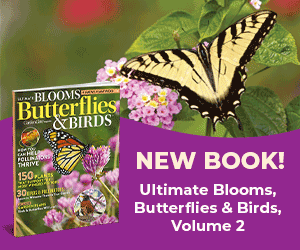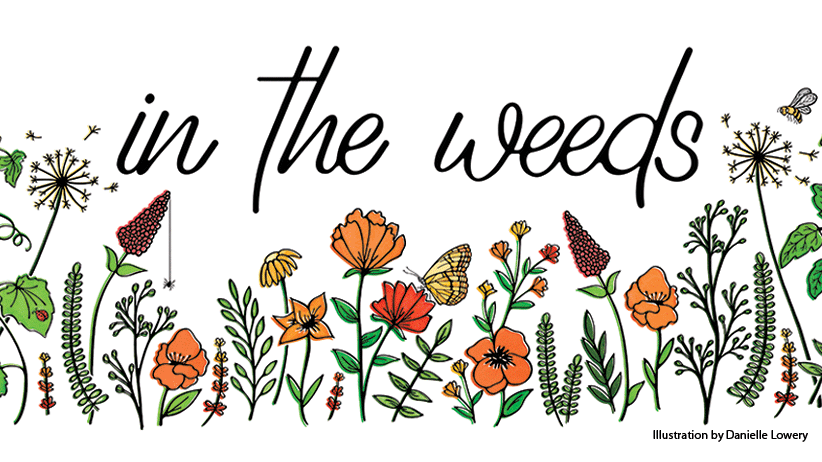
How to deal with garden pests without chemicals
Is there anything worse than seeing a crop of cabbage devoured by cabbage loopers? Or your roses and fruit trees skeletonized by Japanese beetles?
Even when you do all the right things to grow strong, healthy plants, sometimes insect pests invade and wreak havoc. Though you may be tempted to reach for a pesticide spray, here are seven eco-friendly ways to protect your plants from pesky insects.
1. Use a stream of water to remove bugs
Something as simple as hosing a plant down goes a long way toward keeping soft-bodied insects at bay. A strong stream of water will knock them off, often killing them in the process.

Common offender: Green aphids
Tropical hibiscus (Hibiscus rosa-sinensis), above, is a favorite snack for green aphids, especially tender new growth, flower buds and petals. Blast them off with water from a fine sprayer or hose nozzle. For extra control, add 2 tsp. of Dawn® dish soap per pint of water and spray the plants down with a pump sprayer — the soapy film adheres to the aphids, removing their protective coating and causing them to dry out and die. A bonus: Adding soap helps clean off any sticky honeydew left behind by the aphids’ feeding. Be sure to rinse the plant with fresh water afterward to prevent soap residue from clogging the plant’s pores.
Try using a stream of water method to remove these common garden bugs
- Oleander aphids (Aphis nerii)
- Green aphids (Aphis gossypii)
- Twospotted spider mites (Tetranychus urticae)
- Whiteflies (Trialeurodes vaporariorum)
Related Articles:
5 No-Pull Methods to Get Rid of Weeds
DIY Fungus Fighting Recipes for the Garden
Gardeners Problem Solver Book Bundle
2. Remove bugs by hand
For large, easy-to-spot pests, it’s easy to handpick and squash them or drop them into a bucket of soapy water to drown. Remove smaller, harder-to-pick insects by trimming off branches, leaves or flowers that are infested.

Common offender: Tobacco budworms
Tobacco budworm damages petunia (Petunia spp. and hybrids) flowers by chewing holes through the petals in the bud stage. The brown or green worms are easily camouflaged in foliage, but look closely and you’ll spot them. Check plants daily in the late afternoon or evening when the critters are most active. Pluck and destroy them.
Handpick these insects:
- Bagworms (Thyridopteryx ephemeraeformis)
- Japanese beetle (Popillia japonica)
- Tobacco budworm (Heliothis virescens)
Cut off infested portions of the plant when you have:
- Mealybugs (Planococcus spp.)
- Scale
3. Introduce predatory insects
Watching predatory insects devour a problem pest can be very satisfying. Most predators target specific insects to eat or parasitize. Research your pest, and encourage its natural enemy to visit your garden by providing overwintering sites and food sources the predatory insect might also need in other stages of its life cycle, such as pollen or nectar. You may even be able to buy live predatory insects to release in your garden. It’s not a quick solution, but it is ecologically friendly.

Common offender: Tomato hornworm
If you’ve ever seen a tomato hornworm covered with tiny white rice-like objects, these are the larval cocoons of the braconid wasp. The adult wasp lays its eggs on the hornworm. When the eggs hatch, the larvae feed on the caterpillar, eventually forming the white cocoons that you see attached to its body. Although unsightly, leave the infested hornworm in your garden — wasps hatching from the cocoons seek out more hornworms to parasitize and kill.
Try these natural predators:
- Green lacewing larvae (Chrysoperla rufilabris) feed on twospotted spider mites and aphids.
- Lady beetles (Hippodamia convergens) eat countless aphids, leafhoppers (Empoasca fabae) and mealybugs.
- Spiders are predators of many insects.
- Braconid wasps (Cotesia congregata) cover tomato hornworms (Manduca quinquemaculata) with tiny larval cocoons that hatch and then feed on the caterpillar.
You Might Also Like:
Beneficial Garden Insects
7 Common Garden Pests
Sign Up for the Garden Gate Weekly Newsletter!
4. Use biological pathogens
Bacteria, fungi, beneficial nematodes and viruses can be used to kill pests. These biologicals are usually effective only on a specific insect, are introduced to infested plants with sprays, granules or powders, and they work in unique ways. This method works slowly to reduce populations.

Common offender: Japanese beetles
Japanese beetles (Popillia japonica) in the juvenile stage are grubs that live underground. Populations can be reduced by introducing a beneficial nematode (Heterorhabditis bacteriophora), a microscopic organism that, once ingested, emits a bacterium that kills the grub. The nematode then reproduces and seeks out more grubs. Nematodes are light sensitive and best applied by being mixed with water and sprayed on damp soil at dusk or on a cloudy day.
Try these pathogens to control pests:
- Bt (Bacillus thuringiensis israelensis) is a bacteria used to control fungus gnats (Bradysia spp.) in houseplants and mosquitoes in ponds.
- The fungus Beauveria bassiana kills Colorado potato beetle (Leptinotarsa decemlineata) larvae and adults.
5. Add sticky traps
Have you ever caught your hair in fly tape? Then you know exactly how a sticky trap works just above the soil surface. Adults fly to the trap, become stuck and die. An adhesive (or petroleum jelly works for small, weak insects) is applied over something that will attract a pest insect: colored cards, tape, ribbon or even fruit-shaped decoys. The insect becomes stuck and dies after landing on the trap. The downsides of these traps are that they will also catch beneficial insects accidentally, and small birds can get stuck or become covered with sticky adhesive that they can’t clean off.

Common offender: Fungus gnats
The best way to catch fungus gnats in houseplants is with a yellow sticky trap. Attach a trap to a stake inserted in the soil at the base of the plant. While it won’t kill the larvae in the soil, the trap will catch the adults as they emerge and kill them before they can lay more eggs. It’s best to leave the trap for several weeks and change it when it is full.
Match the color to the pest:
- Yellow sticky traps just above the soil surface. Adults fly to the trap, become stuck and die. These attract whiteflies (Trialeurodes vaporariorum) and aphids.
- Blue traps catch leafminers and thrips.
- Red apple-shaped traps attract and kill apple maggot flies (Rhagoletis pomonella).
Related Links:
Do You Know These Common Houseplant Bugs?
8 Ways to Get Rid of Fungus Gnats
Spider Plant Takeover | In the Weeds Humor Column
Tips for Decorating with Houseplants
6. Pheromone traps
A pheromone is a hormonelike substance secreted by insects that enables them to find a mate or follow a trail to food. This control method often combines a sticky adhesive with an artificial pheromone bait, specific to the insect species you want to trap. This pheromone lures the adults, usually the males, into a disposable trap, where they become stuck. While it may not eliminate all the pests, it can reduce the population enough in a home garden that damage is not significant.

Common offender: Codling moth
To prevent codling moths from damaging orchard fruits, such as apples (Malus spp. and hybrids), hang one pheromone-infused sticky trap in a dwarf fruit tree and two in a full-sized standard tree.
Pheromone traps can lower populations of:
- Codling moths (Cydia pomonella)
- Spotted lanternfly (Lycorma delicatula)
- Squash vine borer (Melittia cucurbitae)
AVOID using pheromone traps for Japanese beetles
Studies have shown that the traps for Japanese beetles tend to attract more pests than they deter!
7. Plant trap crops to control insects
A trap crop is a plant that is so tasty to an insect that it will pass by other food sources to feed on it. Plant the trap crop close to or around the perimeter of plants you want to keep pest-free. You’ll still get some insect damage on your preferred plants, but much less. Get rid of the pests by picking them off, removing the infested plants completely, or growing the trap plant in a pot and dunking it in soapy water to kill the insects.

Common offender: Cucumber beetles
Blue Hubbard squash (Cucurbita maxima) is especially attractive to cucumber beetles (Diabrotica undecimpunctata howardi) and squash vine borers that damage winter squash and zucchini. Plant Blue Hubbard plants like a fence around the desired plants. The key is to start the trap crop earlier so the plants are bigger and more likely to lure the insects away from the prize crops.
More trap-cropping companions:
- Plant collards around cabbage to keep diamondback moths (Plutella xylostella) away.
- Plant dill near tomatoes to lure tomato hornworm (Manduca quinquemaculata).
- Plant nasturtium (Tropaeolum majus) to lure aphids and flea beetles (Disonycha xanthomelas) away from vegetable crops.
Sources for natural insect controls
- Arbico Organics, arbico-organics.com
- Gurney’s Gardens Alive, gurneys.com
- Gardener’s Supply, gardeners.com















